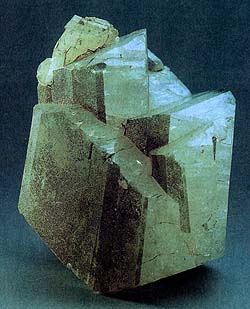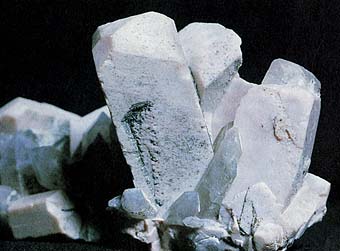Stone, minerals and semiprecious of the world stone
Feldspar (silicates): Orthoclase -->rus
 Diagnostic cart.
Diagnostic cart.
On a photo. If opal color of stone has difficult whitish reflexes of the deceitfully-varied flowings, it is a jeweller variety of orthoclase - Moon stone (adularia, adular).
K Al Si3 O8
Crystal structure monoclinic
Hardness on the Mohs scale 6
Specific unit weight mass 2,53-2,63
Cleavage perfect absolute
Fracture, break padman
Colors colourless, polycoloured (multicoloured)
Colors in powder triturate white
Glance (glitter, glare) from glass to mother-of-pearl

Calcareous (chalky)- natron sodium feldspar (plagioclase). Crystallized mostly as short-prismatic crystals, rarer - extended, which can arrive at giant sizes. Crystals almost always paired twin (duplex). A mineral also be found as considerable dense the masses. Fragile frail brittle and having padman fracture, Orthoclase hard, but enough easy. It can be both transparent and colourless, sometimes translucent and opaque, painted in white, light-grey, pink, rose, rather yellow color. Glance (glitter, glare) from glass to mother-of-pearl, sometimes mineral seems porcelain-like. In the sprinkle of snow it always white. Orthoclase has two planes of cleavage, intersecting at right angles; from it there is his name (Orthoclase in Greece means a direct fracture).
Plagioclase is a series of feldspar minerals consisting of a mixture of sodium and calcium aluminium silicates in triclinic crystalline form: includes albite, oligoclase, and labradorite. Orthoclase is a white to pale yellow, red, or green mineral of the feldspar group, found in igneous, sedimentary, and metamorphic rocks. It is used in the manufacture of glass and ceramics. Composition: potassium aluminium silicate. Formula: KAlSi3O8. Crystal structure: monoclinic.
Chemical composition (chemistry, compound). Oxide of potassium (K2O) 16,9%, oxide of aluminium (Al2O3) 18,4%, silex (SiO2) 64,7%, a few percents of oxide of natrium sodium are often present (Na2O); if the amount of Na is exceeded by an amount to K, mineral is named natron sodium orthoclase, or anorthoclase.
Form of crystals. Prismatic, columnar, basaltiform, plate tablet lamellar, frequent twins of accretion on the lateral verge of M are the so-called Carlsbad twins. Crystalline structure. Silicate with endless three-dimensional framework (Si,Аl) of O4. Class of symmetry. Prismatic - 2/m. Cleavage. Very much to the goodпо base (Р) (001), distinct on an end verge (M) (010) and on a prism (T) (110). Aggregates. Dense, grainy, spar-like.
Diagnostic indication.
In flame of candle melt fuse hardly. Not added the action of acids, except for a fluorine, which decomposes him fully. Svetlo-pink, rose, reddish (colors of meat), reddish-white, brown-yellow, gold, white, grey, colourless.
Origin provenance genesis.
Widespread mineral; it is considered the widest meeting among silicates. It enters in the complement of large number magmatic and metamorphic; in addition, be found in ore vein, lode, mines and as grains in many siltages.
Deposit minefield mine field occurrence subsoil.
The beautiful crystals of orthoclase of the light-gray or rose colouring are observed in geode of the Italian granites in San-Pero-in-Kampo on an island Elba, and also in Baveno and Montorfano on a lake major Lago-Major. Other beautiful crystals are in crystalline slates in Cillertale and Valle-vice in area of Trentino.
Use, practical application, deployment.
Orthoclase widely used in porcelain industry: in mixture with a kaolin and quartz it gives plastic and fusible mass. Crystals of high quality - transparent, with light sparks, find application use on jeweller business. As a jeweller stone the rare is used transparent Orthoclase of color of champagne. Be found on Madagascar and in Burma. Entangling him is possible with many transparent yellow stone.


On a photo. Twin Orthoclase. White adularia with a scaly black anhydroferrite (Rio-Marina, an island Elba).
Varieties.
In Monte-Adula in Switzerland (EU) find the magnificent crystals of adulariaа, to the transparent variety of orthoclase. If it opalesce with the reflections of silvery-white color, it is named a moonstone. White adularia - Valencianite - as beautiful crystals obtained on the mine of Silver-City (state of Idaho).
The name "Moon stone" is given for the shining blue flowings (irisation) reason of which is a platy structure of mineral. Sometimes there is an effect of "cat's-eye". Very shock-sensitive and to the compression. The most known mine deposit is in Sri Lanka, other - in Australia, Burma, Brazil, India, Madagascar, Tanzania and USA. Polished cabochons. Moon stone it is possible to entangle with chalcedony or synthetic spinel. There are imitations from glass. Can possess a "lunar" ebb also albite, oligoclase, Microcline.
Anortoklaz is feldspar, being a sosoloid of orthoclase in an albite. It is so adopted because it does not have cleavage at right angles. Widespread as the masses of lamellar tabular or grainy structure, painted in greyish-white, light-green or light-yellow, gold color. Widespread on the island of Panteleriya (Italy, EU), on the mountain of Kilimanjaro in East Africa, Franclin (the state is New Jersey, USA) and many other places.
